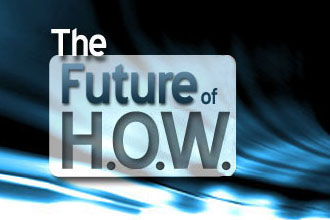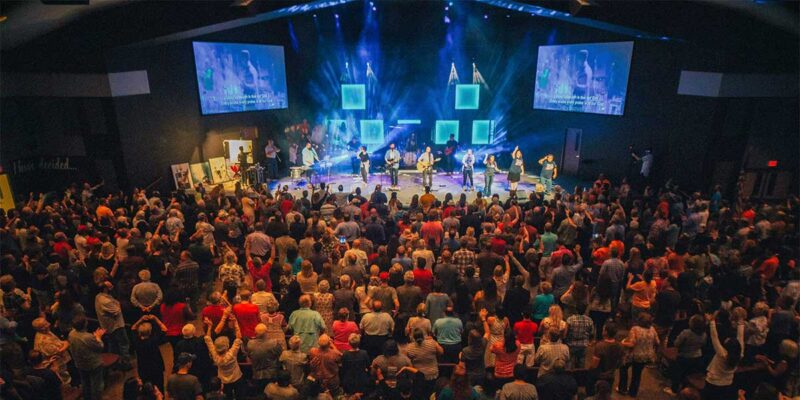Immersive Church Venues
 The forward march of technology has usually meant faster, better, cheaper. In addition to this axiom is a near-future trend for the house of worship market: immersive venues.
The forward march of technology has usually meant faster, better, cheaper. In addition to this axiom is a near-future trend for the house of worship market: immersive venues.
When was the last time you sat with a close friend, in close proximity, for a very personal conversation? As your mind recalls this moment, chances are you’ll first remember where you were, what you were doing and what it felt like. Then, without a noticeable shift, your recollection will blur the ancillary, rendering peripheral vision unnecessary. You’ll remember who it was, what they said, and how it made you feel. These moments are hyper-focused when the discussion is as significant as the friendship.
In much the same way, a great experience at a concert, Broadway-style show or performing arts center can also ‘feel’ very intimate and special. Content, as the saying goes, is king. However, the best venues have increasingly had more detailed acoustical treatments, lighting changes and high-clarity sound upgrades. This is an example of where the secular world is meeting the church world – or vice versa.
Not Just A Service – An Experience
Often found in rural America are the very small churches of yesteryear. These venues had (and many still have) a distinct advantage over today’s modern big-box mega structures: They are intimate. The connection from the pulpit to the furthest pew is measured more in the visibility of the whites of the pastor’s eyes than in feet or meters.
Today, IMAG (Image MAGnification) is used to show a tight-shot of the pastor (or, worst case scenario, a head-to-toe shot) to re-create the intimacy lost in large venues. Hundreds of thousands of dollars are spent to provide the feeling of sitting in that one-on-one conversation with a trusted friend!
Of course, the visual connection to the eyes of the other person is just one part of the experience. The way you feel in a church service still isn’t the same as those intimate connections, in part because of the environment. This is why you’ll find some churches experimenting with services where the music is almost/all acoustic, with candles both for a mood-setting visual as much as the scent.
Some churches have pumped in the smell of incense or other scents for a heightened experience. I recall one church starting a new “at the movies” series of sermons, taking popular movie titles as the name of the messages. This particular church went all-out, starting outside with rented red-carpet, velvet ropes on gold rope stanchions and even popcorn makers to hand out free boxes of the snack. All went well until one of the popcorn machines was allowed to overcook and burn the popcorn – a smell that ruined the wonderful aroma and seemed to endless linger like a bad memory!
A Technical Solution
From the far-out and zany to the ultra-simple, scaled-back retro-utilitarian, churches have tried many ways to make even a modestly large room of 400 feel much smaller and more personal. Technology continues to open up new possibilities for creating more intimate, meaningful and personal experiences. I’ve highlighted a few technologies that I believe will have bright futures in this emerging church trend.
Lighting
From LED curtains to LED architectural fixtures to conventional lighting with color-changers, the visual spectrum can now more affordably be splashed across more than the platform or stage. With audience lighting submerging the people below in deep shades of cool or warm colors, the senses are shaped to feel more calm and peaceful or more exciting and energetic. Working with architects, it’s possible to treat the entire room as a giant canvas for light, color and texture. With patterns and gobos, scripture can be splayed across the ceiling walls and floor. Stained glass can be virtually applied to any surface and even clouds, sky and stars can appear with vivid reality on ceilings and prosceniums.
Lighting controllers have long been used to great effect for sweeping scene changes, but with more controls for color-mixing and syncing with music, minutes-long transitions can bring imperceptible changes from hue to hue, season to season or scene to scene – all without the audience ever realizing a change is slowly taking place, only absently aware that the experience is subliminally altering around them.
Video
Yoke-based projection and mirror-based projection angling can add depth, dimension and motion to those clouds on the ceiling or stained glass cascading down the wall onto the floor. Subtle projection is an art-form in and of itself, exceeding the typical expectations of mere slide lyrics or image magnification.
LED curtains here, too, provide indoor and outdoor opportunities for video to follow the contours of a building or framework. With churches building more performing arts venues, flying LED curtains in orientations other than 90-degree vertical are possible.
High definition video has matured and, simultaneously, decreased in price, allowing churches to bring extreme realism to a 2D medium. Certain applications, such as video venues, are already adopting high-resolution life-sized images of the pastor on screens even with the floor of the platform. Environmental projection is a current trend that will continue to increase in popularity.
3D is the next trend, with planar projection (laser projection is looking promising for this, too) or other holographic-style technologies allowing for ultimate suspension-of-disbelief.
Audio
The changes in digital audio have been stunning. The quality-to-price ratio continues to widen exponentially and churches are now able to actually provide movie-quality sound to even medium-sized venues. Perhaps most notable is the ability to adapt instantly between speech and music through tremendous processing now on the market that enables even volunteer-level operators new opportunities for professional-grade mixing.
More than what you do hear is the incredible advancements in both digital signal processors and speaker design that lower the noise floor to nearly imperceptible levels.
The Combination Effect
All of these technologies and advancements are incredible in their own right, but it is the combination of these that is what allows churches to realistically consider creating immersive environments. Of course, this will require the combined effort of the manufacturers and systems integrators or consultants. This is a future trend, however, so I expect to see this start to make more than the occasional headlines within the next three to five years.
Churches, by and large, are not going to be getting physically smaller — especially with the trends in today’s growing congregations. But there is the opportunity here for them to feel much, much smaller and far more intimate. Perhaps even as intimate as a small church of yesteryear.
A former staff member at three mega churches and church technology consultant, Anthony Coppedge has developed a respected reputation as a leader in technical and communications circles within the church marketplace. Reach him at anthony@anthonycoppedge.com or on Twitter.





